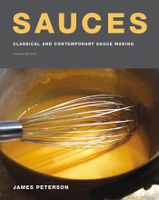Advertisement
Purées
Appears in
Published 1991
Vegetable and fruit purées can also be used as thickeners; they function in different ways depending on how they are used and what natural thickeners and emulsifiers they contain. Some vegetable purées contain sufficient starch that helps them emulsify, but most purées contain insoluble components that give purée-thickened sauces a relatively rough texture and matte appearance. They also contribute flavor, whereas plain starch does not (at least not an agreeable one). Some purées, such as those made with tomato or green vegetables, contain so little starch that they thicken a sauce simply by adding a large bulk of fine solid particles to a liquid medium. Sauces thickened with these purées alone will separate into liquid and solid (syneresis)—think of the way liquid separates from carrot or tomato purée near the edge of the plate when left to sit—unless another liaison is used along with the purée. Vegetable purées are also used in vinaigrettes, where they prevent the vinegar (or other acid) and the oil from coalescing (joining up into larger globules). In most cases, when using vegetable purées as thickeners, it is a good idea to add an emulsifier such as propylene glycol alginate to the water phase (including the purée) and liquid lecithin to the oil or fat.


